|
Where can we find wild durians in Singapore? The National Parks Board had planted out the saplings
from the seeds at Mount faber Park 2 and Jalan Jurong Kecil 1.
Where to buy them in Sarawak? According to Simon Longman, he suggested going to Kuching Sunday Market in
Jalan Satok, Kuching, Sarawak in December or January. One such wild durian may cost you RM 15 - 20.
It cost RM30 for 4 in the whole tamu’ (Sunday market).
According to Sabah Tourism, Culture and Environment Minister Datuk Masidi Manjum, in interior Ranau sukang (Durio
gravolens) are plentiful. Wild durian known as sukang or tabelak, the fruit is also called 'durian hutan', is mainly found
growing wild in the jungles of Sabah. The sukang's main attraction is its red-coloured flesh. 'That's the main thing that
makes it stand out,' he said, adding that this type of durian also fetched a lower price than the more common fruit.
The small-sized fruits, some about the size of a sepak takraw ball, are sold for as little as RM2 to RM3 when they are
in season. It is more pungent and has a carrot-like flavour.
Above information is from Straits Times(28 Sep 2009)
| Not Rambutan. Wild durian with yellow meat |
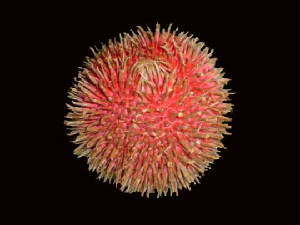
|
| Known as Dulcis or Lahong |
| Wild Durio Oxleynus |
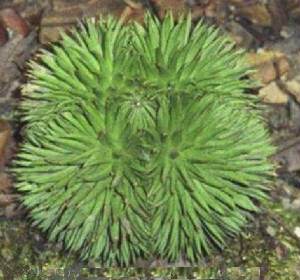
|
| Green Outer Skin |
| Wild Durio Dulcis |
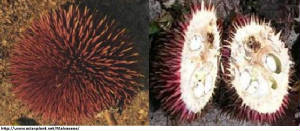
|
| Red Outer Skin |
| Wild Durio Oxleynus (Sukan) |

|
| Green Outer Skin (Yellow meat) |
Lahong (Durio Dulcis) - This is from East Borneo. A wild Burning red skin durian. Fruit
is quite round. Yellow flesh is so creamy, soft and sweet just like caramel. Despite its sweet taste, the smell of this type
of Dorian is very provoking. Fruit 6-10" in diameter, often collected in the jungle and quite difficult
to open, with a deep caramel flavored flesh. Proabably the sweetest of all the durians. The spines are very prominent in this
durian, making the fruit resemble a coiled up sea urchin.
Description: Very large tree to 130ft. Has glossy leaves with a golden color underneath.
Hardiness:
Unknown.
Growing Environment: Unstudied.
Propagation: By seeds.
Uses: Eaten fresh. The seeds are roasted and eaten.
Native Range: Native to Borneo.
|
Durio oxleyanus (Sukang)
Green skin color and smaller size. The average weight is around 20-500gram, the smallest Dorian of all. It has a sweet
yellow flesh but provoking smell. Small fruited, wild durian of Borneo. Fruits are bright green with a hairy appearance, and
strong odor. Occasionally cultivated in Borneo. Description: Large tree, often larger than the common durian. Unlike most other durians which
have five main lobes, the kerantongan has only four.
Hardiness: Unknown.
Growing Environment:
Unstudied.
Propagation: By seeds.
Uses: Fruits are eaten fresh.
Native Range: Native to Borneo.
|
| Wild Durio Acutifolius |
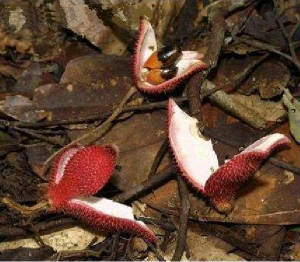
|
| Red Outer Skin |
Wild
Red Aticufolius .
Local
names in Borneo:
Durian, Durian antu, Durian burong, Durian enggang, Durian loiang, Durian lahung, Lai hengang, Lai
kayo, Lai koko, Mehawan, Tupaloh, Tuwola pumpulu.
Fruits
ca. 35 mm long, bright red, dehiscent, with short spines, seeds with small red aril which covers only a small part of the
black seeds.
| Wild Graveolen (Nyekak) |

|
| Wild Graveolens |

|
| Yellow /Green Skin |
Fruits
ca. 150 mm long, yellow-reddish, capsule with long spines, seeds enclosed in red aril.
Durio graveolens, known as durian burung, durian kuning, durian merah, durian otak
udang galah, tabelak or red-fleshed durian. It is a large tree up to tall. The husk of its fruit is orange-yellow, covered
with pyramidal long spines. The fruit has sweet crimson
| Three Different Colours |
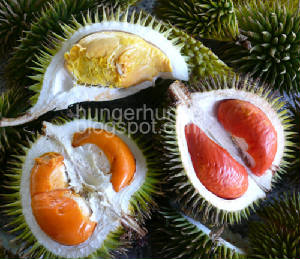
|
| Wild Durians |
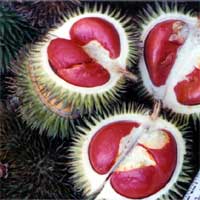
|
| Graveolens |
| Also known as "Durian Hutan" |
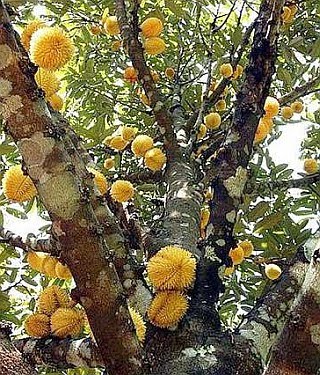
|
| Wild Red Durian Tree (Sabah) |
| Wild Durian |
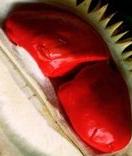
|
| Red Durian Hutan (Sabah) |
| Kura Kura (Testudinarium) |
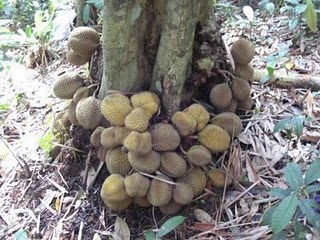
|
| Kutejensis |
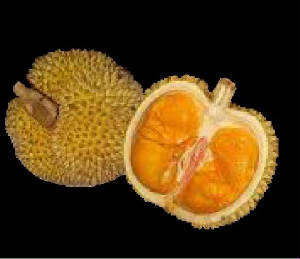
|
| Wild Kuraura (Tesutinanium) |
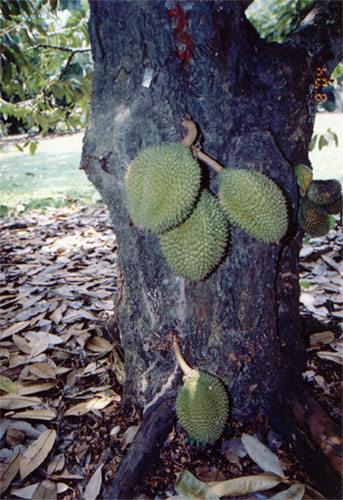
|
| Fruits grown on tree trunk |
KURA KURA (Testudirium)
Medium sized, very rare, wild durian of Borneo. The fruits are pale yellow to brown in color,
flesh is yellow. The flavor is often described as being not as sweet as many of the other durians. Reputedly, the flesh is
stinkier than the common durian and can take quite a bit of getting used to.
Description: No cultivation information is available, although this species occurs wild in the rainforests of
Borneo alongside several of its close relatives. A unique feature of this species is that it flowers and bears fruit directly
from lower portions of the trunk. Large clusters of the fruit hang from the tree just above ground level.
Hardiness: Unknown.
Growing Environment: Unstudied.
Propagation: By seeds.
Uses: Eaten fresh.
Native Range: Native to Borneo
|
